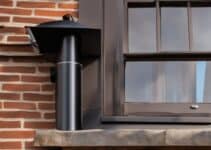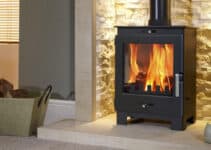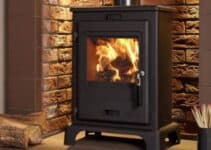As an aficionado of homely aesthetics and functionality, I often find myself in the middle of discussions about the incorporation of a wooden log burner surround in one’s abode. The idea is undeniably charming, conjuring up images of cosy evenings by the fire. However, my investigative journalist instincts kick in when I consider the practical implications of such an addition. In my latest delve into the realms of log burner safety, installation, and decor, I’ve discovered essential considerations any homeowner should be aware of.
Foremost, when enamoured by the rustic allure of wood, one must not underestimate the importance of material suitability, especially concerning heat tolerance. Unlike traditional fire surrounds that may utilise gypsum-based plasters prone to the undermining influence of high heat, log burners necessitate specialised, heat-resistant alternatives for longevity and safety. Engaging in a log burner installation, particularly with a decorative wooded accent, is no trifling matter. It is incumbent upon us to liaise with a HETAS-certified installer to inspect and corroborate that the underlying hearth and the overall structure abide by stringent safety regulations. It’s not merely a practical requirement but a legal imperative.
I take pride in my DIY skills, but I know that, when it comes to log burner decor, even a self-constructed project must adhere to safety norms. The right kind of adhesives, the correct render base, and consistent communication with professional installers are fundamental to ensure any wooden surround is not just visually pleasing but also robust and safety-certified.
Understanding Log Burner Surrounds
As I delve into the intricacies of selecting a log burner surround, it becomes evident that choosing the right materials and adhering strictly to building regulations are not just recommended practices but essential steps for ensuring a safe, efficient, and beautiful fireplace setup. Let’s explore the aspects that one must consider when planning a log burner installation.
The Importance of Selecting Suitable Materials
When contemplating the installation of a log burner surround, my prime consideration is for materials that can endure the rigours of high heat produced by solid fuel stoves. Non-combustible options such as limestone or tiles that can withstand extreme temperatures prove to be wise choices. Such materials, together with the correct type of adhesives, form a protective barrier that not only complements the log burner’s aesthetics but also ensures long-term durability and safety.
Compliance with Building Regulations & Standards
My recommendation cannot stress enough the importance of compliance with existing building regulations and standards. These regulations guide the log burner installation process, ensuring that every component, from the hearth to the flue system, is installed correctly to safeguard against fire hazards and structural damage. It is crucial to ensure that all materials and craftsmanship involved in constructing the surround are in line with the stringent safety standards mandated.
Assessing the Hearth and Constructional Base
In my experience, a strong and heat-resistant hearth is the foundation of any log burner setup. It needs to manage the intense heat without any risk of cracking or damage. Awareness of the suitability of materials, such as marble or a one-piece hearth, is crucial, as some may not be appropriate for a conversion to a log burner. Underneath the aesthetic appeal lies the fundamental necessity of a constructional base that ensures security and functionality.
| Material | Heat Resistance | Safety Rating | Aesthetic Value |
|---|---|---|---|
| Limestone | High | Excellent | Classic |
| Heat-Resistant Tiles | Very High | Excellent | Modern/Varied |
| Marble | Moderate | Good* | Elegant |
*Marble might require additional considerations for suitability.
In summary, acknowledging the demands of log burner safety, understanding the significance of suitable materials, and adhering to the rigours of building regulations are the cornerstones of my guidance for a successful log burner wooden surround installation.
Choosing the Right Type of Wooden Surround
Opting for a wooden log burner surround comes with its own set of considerations to ensure safety and functionality. When you’re faced with the choice between aesthetics and practicality, it’s crucial to weigh both elements to create a balance that complements the charm of your log burner while maintaining adherence to safety protocols. The nuances of freestanding versus cassette stoves, the type of timber selected, and the methodologies employed in a DIY approach are all central to this decision-making process.
Differences Between Freestanding and Cassette Stoves Surrounds
Freestanding stoves offer a traditional appeal, but they demand diligent thought regarding their placement and the wooden surrounds that frame them. The amount of air circulation required not only impacts the stove’s efficiency but also influences the dimensions of your wooden surround. In contrast, cassette stoves are built into the wall, typically necessitating a less complicated surround solution but requiring precision in installation to avoid overheating and potential hazards.
Considering the Heat Output When Selecting Timber
The charm of a log burner wooden surround is undeniable, yet the reality of the heat output cannot be overlooked. It’s my responsibility to consider the type of wood, its proximity to the stove, and the size of the room among my calculations. Compromising on clearance distances could lead to safety issues, hence adhering to stipulated building regulations and manufacturer instructions is non-negotiable.
Crafting a DIY Wooden Surround: Materials and Techniques
Fabricating a DIY surround for your log burner is an inviting project for the hands-on individual; however, it requires more than just woodworking skills. The integration of non-combustible materials like granite tiles and the construction of a solid render base are fundamental to protect the integrity of the wooden surround. A well-executed DIY project should result in an accessory that is both pleasing to the eye and stands up to the high temperatures emitted by the burner.
In my toolkit for a safe and attractive wooden surround, the following table highlights some of the key considerations and suggested materials to ensure durability and compliance:
| Type of Stove | Wooden Surround Considerations | Suggested Materials | Techniques and Tips |
|---|---|---|---|
| Freestanding | Adequate spacing for air circulation | Heat-resistant timbers, Granite or slate tiles | Ensure surrounds are not in direct contact with stove surfaces |
| Cassette | Flush finish with wall, heat dissipation | Metal shields, Plasterboard with high temperature tolerance | Use a shield or constructional hearth to protect the wooden components |
| DIY Surround | Combination of aesthetics and safety | Non-combustibles for immediate surround, Durable hardwoods for mantel | Employ proper insulation techniques and consult installation manuals |
When considering the installation of a wooden log burner surround, you must also include a range of log burner accessories to complete the look and enhance the functionality of your heating system. These can range from practical heat shields to stylistic mantelpieces that underline the beauty of a well-chosen wooden surround. Always remember, the success of your log burner installation lies in a harmonious blend of style and safety measures.
Professional Advice on Log Burner Installation
As an advocate for nurturing a snug and secure home, I cannot stress enough the importance of seeking professional advice during a log burner installation. Consulting a HETAS installer is not merely a suggestion—it is imperative for ensuring log burner safety and adherence to regulations. HETAS professionals possess in-depth knowledge on various aspects of installation, from selecting the correct flue to determining whether your constructional hearth is appropriate for your new stove. A detailed evaluation conducted by a HETAS-certified installer will guide you through the intricacies of building codes and safety standards critical to a successful installation.
One of the key pieces of advice I’ve received pertains to the necessity of a permanently open vent in rooms where stoves exceed a 5kw output. This is fundamental for maintaining a safe environment, as it prevents the build-up of harmful combustion gases. The precision with which a HETAS installer can assess and execute this element of log burner maintenance is invaluable.
Another aspect to consider is the type of stove you intend to install. It may require enlarging the fire opening, and here again, the expertise of a HETAS installer becomes indispensable. Your installer will offer sound, unbiased advice that aligns with your unique requirements and the specific product’s specifications.
It’s worth noting the potential savings in seeking independent installers as opposed to those affiliated with stove retailers. An independent HETAS installer is less likely to be biased by sales quotas, allowing for fair and impartial guidance—often leading to savings on the overall costs of materials and equipment. Nevertheless, I recommend diligence in your selection process to ensure you collaborate with a reputable individual who can facilitate a seamless and safe log burner installation.
- Consult a HETAS certified professional for expert installation
- Ensure compliance with building regulations and safety standards
- Receive impartial advice to optimise your budget efficiently
- Consider the necessity of a permanently open vent for appropriate ventilation
- Invest in professional assessment for suitability of your constructional hearth
- Maximise log burner safety and efficiency with routine log burner maintenance
“Engaging with a HETAS-certified installer is an investment in the safety, efficiency, and long-term enjoyment of your log burner – an indispensable element of any cosy home.”
Finally, I cannot overemphasise the peace of mind that comes from knowing your log burner installation has been executed to the highest of standards. Remember, safety and efficiency walk hand in hand; the professional touch of a HETAS installer will ensure that your home radiates warmth in the safest possible manner.
Log Burner Safety and Ventilation Requirements
As a homeowner who cherishes the cosy atmosphere a log burner creates, I also understand the importance of ensuring the safety and efficiency of its installation—especially when it comes to log burner safety and log burner ventilation. There’s an elegance to the warmth it exudes, but without proper safety measures and ventilation, it could be a hazard lurking in the comfort of our homes.
Ensuring Adequate Air Circulation Around the Stove
It’s pivotal to maintain adequate air circulation around the stove. This isn’t just to optimise the heating efficiency but also to minimise risks. All sides of a freestanding stove, which bathe a space in warmth, need to breathe just as much as we do. The flow of air keeps the temperature from escalating to dangerous levels and ensures longevity of both your stove and its wooden surround.
Permanent Open Vents for High Output Stoves
When dealing with high output stoves, the ones that charm us with their fierce and steady heat above 5kw, laws of practicality demand the installation of permanent open vents. It’s not a mere suggestion but a requirement as per building regulations, tailored to guarantee that there’s always a route for fresh air to enter and support the combustion process, ensuring safety and adherence to standards.
| Stove Output | Room Size | Required Ventilation |
|---|---|---|
| 5kw or less | Small to Medium | Not always necessary |
| Over 5kw | Medium to Large | Permanent open vent |
| 9kw and above | Large | Increased size of vent |
Every homeowner must be scrupulous about not only embracing the ambience and warmth that a log burner provides but also upholding the safety and structural integrity of our cherished abodes. Ventilation isn’t a corner to cut—it’s the very air that fuels the flames we love.
Stylish Log Burner Decor Options With Wooden Surrounds
Embarking on an undertaking to enhance the aesthetic appeal of your log burner space, I advocate incorporating wooden log burner surrounds that not only escalate style but also uplift the entire atmosphere of your room. Gravitating towards log burner decor that champions both elegance and safety is pivotal. A variety of wood materials such as oak, pine, or walnut can be utilised to fashion a surround, on condition that they are correctly positioned at a judicious distance from the stove. These materials lend the space a spellbinding rustic charm that is both welcoming and heartwarming.
For those with an inkling for something that mirrors the allure of timber sans the combustibility, I would point towards non-combustible alternatives such as Geocast beams. These striking log burner accessories masterfully imitate the texture and hue of natural wood whilst being utterly immune to the damage caused by heat and stray embers.
| Material | Type | Heat-Resistance | Visual Appeal |
|---|---|---|---|
| Oak, Pine, Walnut | Real Wood | High (with appropriate distance) | Classic Rustic Charm |
| Geocast Beams | Non-combustible Imitative | Superior | Natural Wood Appearance |
When the desire is to create a harmonious and fully integrated log burner fireplace idea, I suggest considering a full suite which includes a surround, hearth, and interior chamber that are cohesive in design. This assemblage ensures that your wooden log burner surround is not just a standalone piece but a component of a sophisticated and curated fireplace milieu.
To complement the wooden surround, you might ponder over a selection of log burner accessories to perfect the functioning and the form of your fireplace setup. These could range from elegant toolsets to stylish storage solutions for logs, each chosen to complement the tones and textures of the carefully selected wooden surrounds.
In conclusion, adorning a log burner with a wooden surround necessitates a judicious blend of safety, functionality, and style. The materials and accessories you choose can transform an ordinary stove into the centrepiece of your home, resonating warmth and sophistication.
Cost-Effective Solutions for Log Burner Accessories
Finding cost-effective accessories for my log burner was at the top of my to-do list; after all, who doesn’t appreciate a good deal? I realised that investing in quality accessories would not only enhance the efficiency of my log burner but also contribute to the overall safety and aesthetic of my living space. Here’s a summary of my approach to achieving this, which may serve as a valuable guideline for others.
Finding the Best Deals on Stoves and Hearth Materials Online
My initial step was to scour the internet for deals on stoves and hearth materials. I knew that online marketplaces could offer more competitive prices due to lower overheads, translating to better deals for customers like me. Online reviews and ratings proved invaluable, assuring me of quality before making a purchase. As I searched, I specifically looked for reputable brands known for their durable wooden log burner surrounds and other essential log burner accessories.
Benefits of Independent HETAS Installer Consultations
Next, I reached out to an independent HETAS installer for guidance on the installation process. Their expertise was indispensable, ensuring that my cost-effective log burner didn’t only save money upfront but also remained efficient and safe in the long run. This independent advice was tailored to my specific setup, and the installer recommended high-quality, yet affordable, accessories that matched the style and dimensions of my burner. It was a move that undoubtedly balanced economical choices with safety and functionality.
Furthermore, in the pursuit of the most viable cost-saving opportunities, I compiled a comparison table of various accessories sourced online. This allowed me to visualise my options and make an informed decision. Here’s an example based on my research:
| Accessory | Standard Price Range | Online Deal Price Range | Savings Potential |
|---|---|---|---|
| Fireplace Tools Set | £30 – £100 | £20 – £80 | Up to £20 |
| Heat Resistant Gloves | £10 – £40 | £5 – £30 | Up to £10 |
| Log Basket | £15 – £70 | £10 – £50 | Up to £20 |
| Stove Fan | £20 – £120 | £15 – £90 | Up to £30 |
My advice for fellow log burner enthusiasts is to consider all avenues for cost-savings, from purchasing accessories online to consulting with an independent HETAS installer. The combination of these strategies has led me to create a safe, efficient, and inviting ambience in my home, without breaking the bank.
Conclusion
In wrapping up our discussion on the interplay of style and safety in log burner installation, it is clear that a wooden log burner surround can serve as both a functional safety feature and an exquisite element of home decor. My aim throughout this series has been to counsel on the best practices for ensuring that your wooden surround is not just visually appealing but also complies with the highest standards of log burner safety. It is crucial that one selects materials that are able to withstand the significant heat produced by the log burner, and this typically involves the use of heat-resistant substances.
Ventilation, often overlooked in aesthetic design, is equally important. An environment that maintains a fresh air supply reduces risks and enhances the overall log burner experience. Furthermore, enlisting the expertise of a certified installer aligns your endeavour with both contemporary style and the latest safety regulations. Such expertise guarantees that the logistics of your project, from the structural integrity of the hearth to the placement of the surround, are executed with precision.
Finally, I have observed that whether your home leans towards the rustic charm of traditional design or the clean lines of a modern aesthetic, there is an abundance of choices available that can meet your budget without compromising either safety or style. The wooden log burner surround can stand as a testament to this harmonious blend—a centrepiece that warms and invites while reinforcing the solidity and assurance of a well-installed log burner setup. As we move forward, let’s embrace the richness of options at our disposal, crafting living spaces that resonate with warmth, style, and uncompromised safety.



